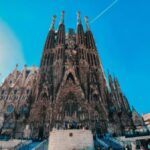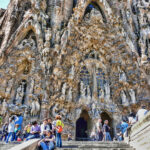
Barcelona, a city renowned for its rich culture and stunning architecture, is home to a true masterpiece that captures the imagination of millions. **The Marvelous Sagrada Familia: Barcelona's Iconic Landmark in Spain** stands as a testament to the genius of Antoni Gaudí, whose unique vision and intricate designs have transformed the basilica into a symbol of the city itself.
This magnificent structure, still under construction after more than a century, combines elements of Gothic and Art Nouveau styles, creating a breathtaking visual experience. Visitors from around the globe are drawn to its towering spires and detailed facades, which tell stories from the Bible and celebrate nature, making the Sagrada Familia a must-see attraction for anyone exploring Barcelona.
Exploring the Architectural Marvel of the Sagrada Familia in Barcelona
Exploring the architectural marvel of the Sagrada Familia reveals a complex interplay of symbolism and artistic innovation. Every corner of the basilica is adorned with intricate carvings and unique forms that reflect Gaudí's deep connection to nature. Visitors can appreciate features such as:
- Nature-inspired designs that mimic the organic shapes of plants and trees.
- The intricate facade sculptures which depict biblical narratives.
- The use of light through stained glass windows that creates a spiritual ambiance.
As you wander through the Sagrada Familia, you'll notice how Gaudí's vision integrates both functionality and artistry. The basilica's structural elements, including the hyperboloid and parabolic arches, not only contribute to its aesthetic appeal but also enhance its stability. This innovative approach allows the building to reach unprecedented heights while maintaining harmony with its surroundings.
Another remarkable aspect of the Sagrada Familia is its ongoing construction, which has been carefully planned to stay true to Gaudí's original designs. The completion of this iconic landmark is anticipated to take several more years, yet the continuous evolution offers a living testament to architectural dedication. Visitors can witness:
- Works in progress that reflect Gaudí's original blueprints.
- The collaboration of modern architects and artisans striving to fulfill Gaudí's legacy.
- Periodic updates on the construction milestones available for public viewing.
In conclusion, exploring the Sagrada Familia is not just about admiring a building; it's about experiencing a cultural phenomenon that encapsulates Barcelona's spirit. This masterpiece serves as an inspiration, inviting all who visit to ponder the fusion of art, faith, and architecture that defines this extraordinary basilica.
The Historical Significance of the Sagrada Familia: A Symbol of Spain
The Sagrada Familia holds profound historical significance that extends beyond its artistic beauty, representing a pivotal chapter in Spain's architectural evolution. Designed by Antoni Gaudí, this basilica is not only an example of modernist architecture but also a symbol of national identity. Its construction, which began in 1882, coincided with a period of cultural and political change in Spain, making it a reflection of the aspirations of the Catalan people.
Throughout its history, the Sagrada Familia has embodied the spirit of resilience. Despite facing numerous challenges, including the Spanish Civil War, which halted construction, the project has continued to evolve. Today, it stands as a testament to the enduring legacy of Spanish artistry and the determination to preserve cultural heritage. The basilica serves as a gathering point for both locals and tourists, fostering a sense of community and shared pride.
Key aspects of its historical significance include:
- The incorporation of religious symbolism reflecting the deeply rooted Catholic traditions in Spain.
- The influence of Gaudí's innovative techniques, which have inspired generations of architects.
- The ongoing construction project that showcases modern engineering while honoring the original vision.
As the Sagrada Familia approaches its anticipated completion, it continues to represent more than just a landmark; it is a symbol of hope and a reminder of the rich tapestry of Spain's cultural history. Each stone and spire tells a story, inviting visitors to reflect on the intersection of faith, art, and national pride.
Gaudí's Vision: The Artistic Genius Behind the Sagrada Familia
Antoni Gaudí's vision for the Sagrada Familia was deeply intertwined with his love for nature and spirituality. He believed that architecture should be a reflection of the natural world, integrating organic forms and colors to create harmony with the environment. This philosophy is evident in various aspects of the basilica, where every design element serves a purpose beyond mere aesthetics.
Gaudí's innovative approach to construction involved the use of unique geometrical shapes that not only enhance the basilica's beauty but also its structural integrity. Key features of his artistic genius include:
- The application of hyperbolic and parabolic arches that optimize strength and stability.
- A complex system of light and shadow created by strategically placed stained glass windows.
- The incorporation of natural motifs that mimic the forms of plants and animals.
In Gaudí's eyes, the Sagrada Familia was not merely a religious structure but a profound expression of faith and creativity. He sought to convey biblical stories through architectural elements, infusing the building with a narrative quality that resonates with visitors. This desire to intertwine spirituality and artistry distinguishes his work from other architectural feats.
The legacy of Gaudí's vision stretches beyond his lifetime, as modern architects continue to draw inspiration from his techniques and ideas. His commitment to innovation is evident in the ongoing construction, which adheres to his original designs while incorporating contemporary advancements. The Sagrada Familia stands as a testament to the enduring impact of Gaudí's genius, inviting all who visit to appreciate the interplay of art, nature, and spirituality.
Visiting the Sagrada Familia: Tips for Tourists in Barcelona
When planning a visit to the Sagrada Familia, it's essential to book tickets in advance to avoid long queues. The basilica draws millions of visitors each year, and securing a time slot online not only saves time but also guarantees access to this architectural wonder. Additionally, consider visiting during the early morning or late afternoon to enjoy a quieter experience and to soak in the beauty of the structure with fewer crowds.
As you explore the Sagrada Familia, take advantage of the audio guide available on-site or through the official app. This guide provides insightful commentary on Gaudí's vision and the basilica's intricate details, allowing you to appreciate the artistry behind each design element. You can also join a guided tour for a more immersive experience, where knowledgeable guides share fascinating stories and historical context.
Don't forget to spend time admiring the stunning stained glass windows, which create a mesmerizing play of light throughout the interior. Each window tells a story and reflects different themes, adding a spiritual dimension to your visit. To enhance your experience, it's recommended to take a moment in the main nave to simply sit and absorb the serene atmosphere.
Lastly, while visiting the Sagrada Familia, consider exploring the surrounding area. The basilica is located in the vibrant Eixample district, where you'll find numerous cafes, shops, and other architectural gems designed by Gaudí. Make a day of your visit by immersing yourself in the cultural offerings of Barcelona, creating a memorable experience that goes beyond just seeing the basilica.
Understanding the Symbolism of the Sagrada Familia's Design Elements
The Sagrada Familia's design is rich with symbolism that reflects Antoni Gaudí's deep spiritual beliefs and his admiration for nature. One of the most notable elements is the use of nature-inspired forms, which can be seen in the basilica's towering columns that resemble tree trunks. This organic approach not only creates a sense of harmony with the environment but also evokes the feeling of walking through a forest, inviting visitors to connect with the divine.
Another significant aspect is the intricate facade details, which are meticulously crafted to tell biblical stories. The Nativity Facade, for instance, celebrates the birth of Jesus through various sculptures that depict scenes of joy and wonder. Each figure and ornament serves a dual purpose, enhancing both the narrative and the spiritual experience of those who enter the basilica, emphasizing Gaudí's belief that architecture should narrate a story.
Light plays a pivotal role in the Sagrada Familia’s design, with stained glass windows intentionally positioned to create an ethereal atmosphere. The vibrant colors filter through, casting a spectrum of light that changes throughout the day, symbolizing the passage of time and the divine presence. This thoughtful manipulation of light not only enhances the aesthetic beauty but also transforms the space into a sanctuary for reflection and prayer.
Finally, the geometric forms utilized in the structure, such as hyperbolic paraboloids, reflect Gaudí's understanding of nature's own geometry. These shapes are not only visually striking but also serve to improve the building's structural integrity, showcasing Gaudí's innovative approach to architecture. By marrying form with function, he created a space that is both awe-inspiring and stable, a testament to the harmonious blend of art and engineering.
The Sagrada Familia: A UNESCO World Heritage Site You Can't Miss
The Sagrada Familia is not only a stunning architectural achievement, but it has also been recognized as a UNESCO World Heritage Site, making it an essential stop for anyone visiting Barcelona. This prestigious designation highlights the basilica's exceptional universal value, which combines artistic, cultural, and historical significance. Visitors can immerse themselves in a narrative that spans over a century, as they explore a structure that embodies the spirit of innovation and creativity.
As you marvel at the Sagrada Familia, you'll discover several key features that contribute to its World Heritage status:
- Unique Architectural Style: The blend of Gothic and Art Nouveau elements creates an unparalleled visual experience.
- Symbolic Facades: Each facade tells a different part of the Christian story, offering profound insights into faith and spirituality.
- Innovative Engineering: The use of modern construction techniques combined with Gaudí's visionary designs ensures the basilica’s stability and resilience.
A visit to this iconic landmark allows you to witness not just a building, but an ongoing journey of cultural expression. The Sagrada Familia's construction is a testament to the dedication of architects and artisans who strive to bring Gaudí's original vision to life. This collaborative effort showcases the importance of cultural heritage, making it a site that symbolizes the enduring human spirit.
In addition to its breathtaking architecture, the Sagrada Familia serves as a focal point for discussions about religious art and community identity in Barcelona. The basilica invites visitors to reflect on their own beliefs and the shared values that unite people across cultures. As you explore this UNESCO World Heritage Site, you'll not only marvel at its beauty but also appreciate the rich tapestry of history and meaning woven into every detail.
 Unlock the Wonders of Sagrada Familia in Barcelona: Secure Your Tickets Now!
Unlock the Wonders of Sagrada Familia in Barcelona: Secure Your Tickets Now! Exploring the Majestic Staircases of Sagrada Familia in Barcelona
Exploring the Majestic Staircases of Sagrada Familia in BarcelonaIf you want to know other articles similar to The Marvelous Sagrada Familia: Barcelona's Iconic Landmark in Spain you can visit the category WHERE YOU CAN GO.
Leave a Reply










Read more!